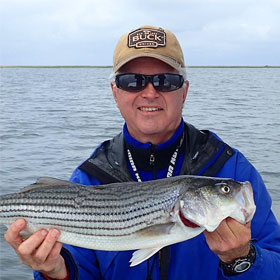Double Your Chances With a Fly Fishing Dropper Rig
By Ken Schultz
Oct 08, 2020
What to know about constructing a fly fishing dropper rig, the types of flies to use with it, plus info on a different two-fly presentation method
One of the best, yet often overlooked, ways to angling success is to double your offerings. For fly casters, this can occur through the use of a fly fishing dropper rig, which is mostly useful in fishing for trout and panfish and when casting small, streamlined flies.
A fly fishing dropper rig is simply a two-fly combo where one fly is above the other on a leader. It is achieved by affixing an auxiliary fly on its own short tippet to a leader ahead of the principal fly. Anglers call this auxiliary fly a “dropper” fly, which is not a type of fly (as in dry, wet, or streamer flies) but merely a term to describe how it is placed on the leader.
Construction
Dropper flies can be used in nymph, wet fly, and streamer fishing, and in combination with dry flies. They are easiest to employ when you tie your own knotted, tapered leader by leaving a few inches of overlap hanging down from the knot used to connect different strengths of leader material. Tie a dropper fly to the protruding line and the primary fly to the end of the tippet.
For further example, a fly fishing leader is composed of a main length of leader line with a section of lighter line, called a tippet, at the end. The tippet and main stem of the leader are joined with a Blood or Uni Knot. When tying the knot, leave about a 12-inch strand dangling from the lighter line, then attach your auxiliary fly to the end of that, leaving a dropper fly extending roughly 6 to 8 inches from the main body of the leader. Finish the fly fishing dropper rig by attaching your primary fly to the end of the main tippet.
(Note: It’s possible to add a dropper fly using a dropper loop knot, although this is not my preference, as this knot is better with heavier tackle and bottom fishing applications.)
Which Flies?
While two different patterns of the same types of flies can be fished simultaneously, like two wet flies or two streamers, it’s common to use a nymph on the dropper in conjunction with a dry as the main fly. In some cases, the dry fly acts as a strike indicator for the nymph.
Using such a fly fishing rig is often a good ploy when prospecting, when there is no visible insect activity, or before a hatch occurs. If two fish in a row strike the dry fly, it’s a simple matter to clip off the nymph. A dropper fly can also be fished with a lure, incidentally, especially a small spoon or spinner.
Another Two-Fly Option
Fishing two flies is possible in other ways besides having a dropper fly rig. These are not technically droppers in that the auxiliary fly is fished directly behind the main fly instead of ahead of it. More of a tandem arrangement, this is accomplished via a short leader attached to the eye of the main fly hook, or to the bend in the main fly hook.
Tying to the eye is generally better for nymphs, while tying to the bend is better for streamers, provided the main hook has a definitive barb. These placements have the advantage of less tangling (during a cast) than using a dropper setup.










